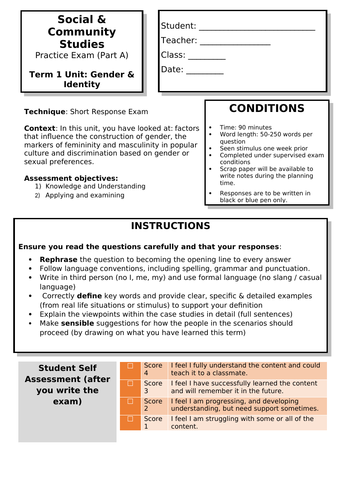





Resource 1: A copy of the seen sources for the practice exam which were provided to students a week prior to the practice examination (to mimic the real assessment conditions).
Resource 2: A copy of the practice exam which can be sat over two lessons to provide the full 90 minutes plus planning time. This is a short response exam with responses ranging between 50-250 words per question. This exam is split into two parts.
Part A includes a section where students must define key terms and provide examples. There is a section where they must explain gender stereotypes about men and women and provide examples. Then, students are provided with a picture of a person and some information about them which they use to respond to questions about what traits they have, what assumptions people might make about the person’s sexuality and whether it is fair to make assumptions about people based on their appearance. Following this, there are 2 scenarios of workplace discrimination which students must read. They choose one to complete a graphic organiser table (identifying the various viewpoints in the scenario). This is followed by an extended response question about this scenario.
In Part B: Students are provided with another practice question where they see an image of a person and read information about their occupation and interests/hobbies before responding to questions about them. Following this, students read a news article entitled ‘What media teach kids about gender can have lasting effects, report says.’ They must write a 100 word response to a question about this article. The next source for the exam is a men’s gillette razor advertisement. Students must explain the effect the advertisement could have on female and male audiences. The same style question is posed again for a Burger King advertisement which uses sex appeal to sell the product. After this, students must explain Australia’s Sex Discrimination Act (1984) and the types of discrimination it prohibits. Finally, the examination concludes with an extended response question where students must decide if the representations of gender in the media have a negative or positive impact on people and justify their answer with evidence from at least 2 sources.
Part of a set of resources created for a senior Social & Community studies class in Australia (QCAA syllabus). The other resources are also available in my store - Aussie_Resources.
Something went wrong, please try again later.
This resource hasn't been reviewed yet
To ensure quality for our reviews, only customers who have purchased this resource can review it
Report this resourceto let us know if it violates our terms and conditions.
Our customer service team will review your report and will be in touch.
